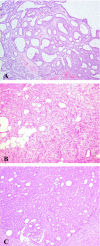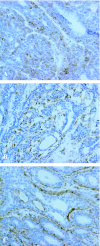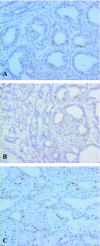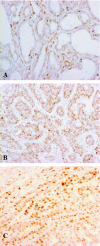Promoting effects of milk on the development of 7,12-dimethylbenz(a)anthracene (DMBA)-induced mammary tumors in rats
- PMID: 17576434
- PMCID: PMC1874511
- DOI: 10.1267/ahc.07008
Promoting effects of milk on the development of 7,12-dimethylbenz(a)anthracene (DMBA)-induced mammary tumors in rats
Abstract
To assess the effect of milk on the development of 7,12-dimethylbenz(a)anthracene (DMBA)-induced mammary tumors, 48 female Sprague-Dawley rats treated with DMBA were divided into 3 groups and given 1 of 3 test solutions for 20 weeks as their drinking liquid: milk, estrone sulfate solution or tap water. The milk group showed a significantly great incidence (75%) in tumor development compared with the water group (38%) and was comparable to the estrone sulfate group (69%). Mean tumor number per rat in the milk group was significantly higher than that in the water group (p=0.009). We classified the mammary tumors into three histological types: intraductal papilloma, fibroadenoma, and adenocarcinoma. Although the percent of intraductal papilloma and fibroadenoma was almost same among the three groups, malignant tumor was found only in the milk and estrone sulfate groups. In conclusion, our results indicate that milk as well as estrone sulfate promotes the development of DMBA-induced mammary tumors in rat and could be associated with the occurrence of adenocarcinoma.
Figures




Similar articles
-
Low-fat milk promotes the development of 7,12-dimethylbenz(A)anthracene (DMBA)-induced mammary tumors in rats.Int J Cancer. 2004 Jul 1;110(4):491-6. doi: 10.1002/ijc.20172. Int J Cancer. 2004. PMID: 15122580
-
Exposure of Sprague-Dawley rats to a 50-Hertz, 100-microTesla magnetic field for 27 weeks facilitates mammary tumorigenesis in the 7,12-dimethylbenz[a]-anthracene model of breast cancer.Cancer Res. 1999 Aug 1;59(15):3627-33. Cancer Res. 1999. PMID: 10446973
-
Influence of caffeine on development of benign and carcinomatous mammary gland tumors in female rats treated with the carcinogens 7,12-dimethylbenz(a)anthracene and N-methyl-N-nitrosourea.Cancer Res. 1991 Jul 1;51(13):3399-404. Cancer Res. 1991. PMID: 1905195
-
Effect of milk on the 7,12-dimethylbenz[a]-anthracene-induced mammary tumor model in rat.Food Chem Toxicol. 2007 Oct;45(10):1868-72. doi: 10.1016/j.fct.2007.03.020. Epub 2007 Apr 14. Food Chem Toxicol. 2007. PMID: 17540491
-
Chronic exposure to a GSM-like signal (mobile phone) does not stimulate the development of DMBA-induced mammary tumors in rats: results of three consecutive studies.Radiat Res. 2002 Feb;157(2):183-90. doi: 10.1667/0033-7587(2002)157[0183:cetagl]2.0.co;2. Radiat Res. 2002. PMID: 11835682 Review.
Cited by
-
Network pharmacology integrated with molecular docking reveals the anticancer mechanism of Jasminum sambac Linn. essential oil against human breast cancer and experimental validation by in vitro and in vivo studies.Appl Biochem Biotechnol. 2024 Jan;196(1):350-381. doi: 10.1007/s12010-023-04481-2. Epub 2023 May 2. Appl Biochem Biotechnol. 2024. PMID: 37129744
-
Prepubertal exposure to cow's milk reduces susceptibility to carcinogen-induced mammary tumorigenesis in rats.Int J Cancer. 2011 Jan 1;128(1):12-20. doi: 10.1002/ijc.25313. Int J Cancer. 2011. PMID: 20232392 Free PMC article.
-
The impact of cow's milk-mediated mTORC1-signaling in the initiation and progression of prostate cancer.Nutr Metab (Lond). 2012 Aug 14;9(1):74. doi: 10.1186/1743-7075-9-74. Nutr Metab (Lond). 2012. PMID: 22891897 Free PMC article.
References
-
- Ballard-Barbash R., Swanson C. A. Body weight: estimation of risk for breast and endometrial cancers. Am. J. Clin. Nutr. 2004;63:437S–441S. - PubMed
-
- Bussolati G. Actin-rich (myoepithelial) cells in lobular carcinoma in situ of the breast. Virchows Arch. B Cell Pathol. 1980;32:165–176. - PubMed
-
- Cleary M. P., Maihle N. J. The role of body mass index in the relative risk of developing premenopausal versus postmenopausal breast cancer. Proc. Soc. Exp. Biol. Med. 1997;216:28–43. - PubMed
-
- Coleman M. P., Esteve J., Damiecki P., Arslan A., Renard H. Trends in cancer incidence and mortality. IARC Sci. Publ. 1993;121:1–806. - PubMed
-
- Ganmaa D., Sato A. The possible role of female sex hormones in milk from pregnant cows in the development of breast, ovarian and corpus uteri cancers. Med. Hypotheses. 2005;65:1028–1037. - PubMed
LinkOut - more resources
Full Text Sources
Miscellaneous

